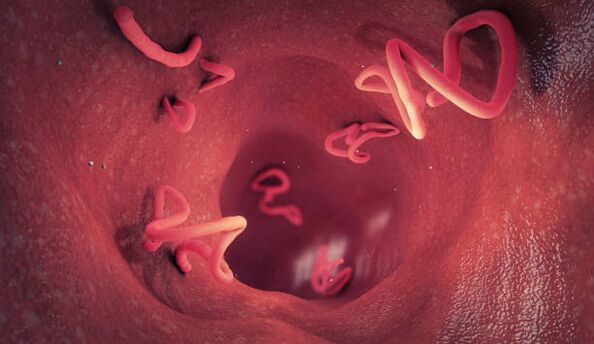Worms are worms that lead a parasitic lifestyle in the body of their host - a person. Age doesn't matter. Both adults and children are equally susceptible to infection. The classification of helminthiasis is very extensive, especially in countries with hot climates.

There are 3 classes of parasitic worms:
- roundworms (nematodes) - pinworms, roundworms;
- tapeworm (cestode) - swine tapeworm, bovine tapeworm, echinococcus;
- flatworms, flukes (trematodes).
The most common worms in children are pinworms that cause enterobiasis. These helminths are small in size, on average up to 1 cm, white-gray in color with a curved body. The site of localization of these parasites is the large intestine, but they can also penetrate the lower parts of the small intestine. Pinworms multiply on the skin near the anus. At night, pinworm females come out to lay eggs in the folds of the skin, often penetrating the labia of girls, ending in infectious diseases of the genitals. In total, these helminths live about 1-1, 5 months. The process of self-infection in a child can lead to the fact that fatigue will continue for many years. Parasites can be detected with the naked eye in the feces.
Roundworms are another type of worm that are most common in children. Of the characteristic species, which reach a length of 15 cm, these nematodes precipitate in the lumen of the loop of the small intestine, moving towards the mobile lump of food. Worms enter the stool very rarely. Females occasionally lay eggs that can be found in fecal analysis. But if they are not found during the study, it does not mean that the child is not infected. The life cycle of a roundworm can take several years.
Reasons
The baby's curiosity is realized by the fingers, the child, learning about the world, actively touches everything that comes to hand and immediately pulls it into his mouth, trying to gain strength and taste. Thus pinworm eggs safely enter the digestive tract of their future little host.
The child becomes infected with worm eggs from the surface of unwashed fruit, when he drinks contaminated water. Very often, the infection occurs when communicating with animals or when playing in the ground, sandbox, where cats and dogs like to solve their physiological problems. After a walk, children often do not wash their hands, and all the dirt, along with parasitic eggs, enters their mouths.
Symptoms
If a child is infected with a large number of parasitic worm eggs, a sudden deterioration can occur in a few days. In milder cases, the first symptoms of invasion appear after a few weeks or even months. Much depends on the immunity of the child. It could deal with parasites and slow their development. But gradually the defensive strength decreases and the helminths infect the body, causing serious problems.
The first signs are symptoms of poisoning (intoxication). The vital activity of the worm is accompanied by the release of a large number of animal toxins that can poison the child's body. In the intestines, parasitic worms use nutrients, as a result of which the baby gradually lacks protein, carbohydrates, fats and vitamins.
The child has:
- thinness,
- pale skin,
- weakness, frequent dizziness,
- fever, headache,
- bad dream
- payability,
- depressed mood.
Intestinal diseases are manifested - constipation, loose stools, rumbling and abdominal pain, bouts of nausea and vomiting, painful sensations in different parts of the abdomen and bloating. The disease can be accompanied by allergic conditions: itching, rash, cough, inflammation of the mucous membranes of the respiratory tract. Weakening of immunity leads to the addition of infectious diseases.
Diagnosis and treatment
The diagnosis of helminthiasis in the feces is quite difficult. This is due to the fact that roundworm eggs or pinworms do not appear in the feces every day, and the smear microscopy technique from the analysis requires great care. In order to increase the reliability of the analysis of feces for worm eggs, it is recommended to take it for at least 3 days in a row.
In cases of increased risk of worm infection (contact with animals, the child's playing on the ground or in open sandboxes, the child's habit of taking things in his mouth, biting his nails or licking his fingers, etc. ), it is advisable to undergo an in-depth examination, includingtriple stool analyzes, and special blood tests that detect antibodies to helminths.
In the presence of allergic manifestations of unknown origin, increase in the number of eosinophils in the blood test, persistent intestinal dysbiosis, it is recommended to give blood for the determination of class E immunoglobulins (Ig E and G) to roundworms and other helminths. Can you check for worms in pets.
Assessing the totality of indirect signs and anamnesis, the doctor may recommend anthelmintic therapy without direct evidence of the presence of worms in the child, if other pathologies that cause similar clinical manifestations of all family members are excluded to avoid foci of infection with helminth eggs. In this situation, in addition, it is necessary to strengthen hygienic measures, especially to cook and iron the bed and personal laundry on both sides.
























